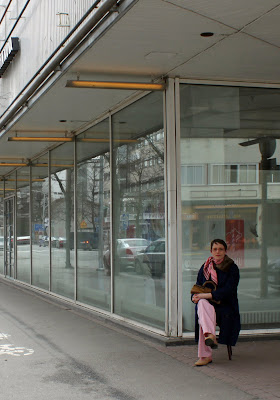I'm pleased to meet you in the mountain is a two weeks durational performance series for the city of Pori which consists of ten different 12 hours durational solo performances and the daily documentation will grow and been shown in the Generator Gallery, Pori in May 2010.
The focus of interest in the performance series are the moments of encounter between the performance artist and the audiencce - this moment is a moment of direct communication in the present moment of lived experience, while it is taking place – not how it is later described in a different manner. “So much can happen in one moment that only lasts a few seconds. A micro-analysis, so to speak, that at the same time directs attention to a dimension of reality that proceeds on the assumption that the world changes while one is observing it. “ (Theurich, April 2009)
To understand this short moment of encounter and with help of different artistic methods this moment of communication will be created. “In order to leave the communication gaps behind us, or tries to diminish these gaps, we have to create more open spaces for encounter.“ (Theurich, March 2010)
During the first week, the focus will be on the creation of different poetic live pictures which will set up in the city centre of Pori and in the second week strangers will be invited on the street to do something with the artist together or just for her.
The duration is an important part of the communication process with the residents of Pori, to slow down the everyday life habit of perception from the pedestrians to undermine the experiences of everyday city life. “For a new dimension of deep encounter, this change of energy in the public space is essential.” (Theurich, March 2010)
My expectations before the start of the production in Pori are very high - maybe to high, but time will answer this. I hope that I can get more knowledge and a deeper understanding of the moment of encountering. I will take a look at the duration and discover, for my continuing performative work, if the duration is still an important part of the communication process. I want to slow down the every day life habit of perception from the pedestrians to undermine the experiences of every day city life.
All performances during the exhibition “Live Art Generator” are dealing with the same research questions and I hope to get some answers or at least some directions how to deal with the following questions after the project:
The focus of interest in the performance series are the moments of encounter between the performance artist and the audiencce - this moment is a moment of direct communication in the present moment of lived experience, while it is taking place – not how it is later described in a different manner. “So much can happen in one moment that only lasts a few seconds. A micro-analysis, so to speak, that at the same time directs attention to a dimension of reality that proceeds on the assumption that the world changes while one is observing it. “ (Theurich, April 2009)
To understand this short moment of encounter and with help of different artistic methods this moment of communication will be created. “In order to leave the communication gaps behind us, or tries to diminish these gaps, we have to create more open spaces for encounter.“ (Theurich, March 2010)
During the first week, the focus will be on the creation of different poetic live pictures which will set up in the city centre of Pori and in the second week strangers will be invited on the street to do something with the artist together or just for her.
The duration is an important part of the communication process with the residents of Pori, to slow down the everyday life habit of perception from the pedestrians to undermine the experiences of everyday city life. “For a new dimension of deep encounter, this change of energy in the public space is essential.” (Theurich, March 2010)
My expectations before the start of the production in Pori are very high - maybe to high, but time will answer this. I hope that I can get more knowledge and a deeper understanding of the moment of encountering. I will take a look at the duration and discover, for my continuing performative work, if the duration is still an important part of the communication process. I want to slow down the every day life habit of perception from the pedestrians to undermine the experiences of every day city life.
All performances during the exhibition “Live Art Generator” are dealing with the same research questions and I hope to get some answers or at least some directions how to deal with the following questions after the project:
How does the perception of reality change while at the same time one is observing or direct involved in a performative encounter?
How can we diminish communication gaps?
How does durational performance in public space influence the perception from the pedestrians and the experiences of every day city life?
How to create a performance space for deep encounter?





